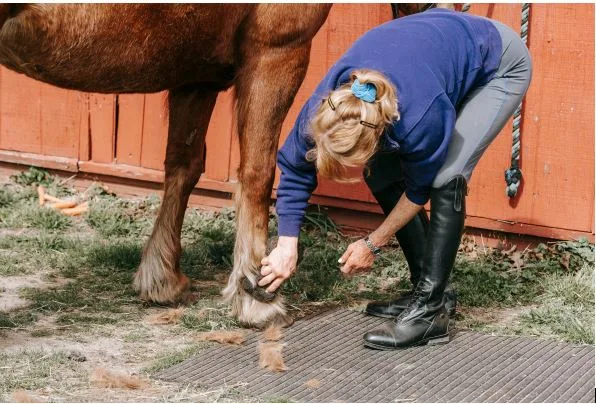Why Is Regular Hoof Monitoring Important for Horses?
A horse’s hooves are fundamental to its overall health, mobility, and comfort. “No hoof, no horse.” Daily observation of the hooves is essential in staying sound, detecting early warning signs of possible issues, and maintaining long-term joint health. Having a competition horse or companion, habitual daily practices of hoof maintenance can make your horse healthy and well-functioning.
Understanding the Connection between Hoof Health and Overall Soundness
The foundation of the entire equine musculoskeletal system is the horse hooves. Stress is passed with each step through the hooves to joints, tendons, and ligaments. When the hooves are out of balance, cracked, or uneven, that stress may be passed along to the rest of the body, potentially affecting the location and comfort of joints.
Maintenance by means of regular inspection prevents the structure of the hoof wall, sole, and frog—from becoming out of balance and deteriorated. Farriers and equine experts are able to detect early warning signs before they become full-scale issues, reducing the risk of strain that can endanger the horse’s long-term mobility.
Early Detection of Founder in Horses
Laminitis or founder in horses is one of the most critical hoof diseases. It is when the laminae of the foot become inflamed and there is a separation between the bone and hoof wall inside. The disease should be diagnosed in its earliest stage so that the comfort and well-being of the horse can be maintained.
Daily observation of the hooves will detect warning signs for:
- Change in hoof temperature or pulse
- Digital pulse absent or irregular digital pulse
- Foot-rocking
- Wetness of firm walking surface
- Irregular hoof wall growth rings
Warning signs, if noticed by owners regularly, will enable owners to check hooves on a regular basis and address those more subtle warning signs after consulting experts before a significant structural change.
Hoof Balance and Frequency of Trimming on a Regular Basis
Hooves need to be trimmed 4 to 8 weeks, depending on living habits, health, and activity level of the horse, since they grow continuously. They become uneven in their growth, flare, or crack without regular trimming, altering the normal gait and balance of the horse.
A routine trimming regimen provides consistent weight distribution between the four hooves. This is especially important in joint mechanics and in prevention of stressing shoulders, knees, and hocks. Individual conformation issues or trauma history can be solved by custom trimming or shoeing by farriers.
Nutrition to Improve Hoof Quality
The solution to growth and hardness of the hooves is diet. Proper diet supplemented by biotin and supplements of zinc, copper and amino acids results in strong hoof walls and healthy growth. Lack of such nutrients results in weak, brittle, or growing hooves.
In addition to diet control in total, there are also a few owners who emphasize nutritional supplementation with joint supplements for horses that have ingredients to provide general structural health. The supplements can provide specialized nutrients for connective tissue health and thus the joints and hooves.
Environmental Factors Including Hoof Health
The horse’s living conditions can significantly impact its hooves’ quality and health. Wet-dry cycling, for instance, dries and swells hooves and, thus, cracks or infects them. Staying on wet bedding or muddy paddocks for prolonged times is more inclined to result in bacterial or fungal infection of the type thrush.
Daily hoof inspections encompass checking the environment around the horse—dry; clean footing, regular cleaning of the stall, and adequate turnout. Having a routine, clean setting will allow you to avoid most hoof issues from developing.
Consulting Professionals in Preventive Hoof Care
Periodic consultation with veteran farriers and vets ensures your horse receives specialized care. Farriers are able to adapt trimming or shoeing procedures based on the seasonal transition, level of work, or other ailments that develop, whereas vets can undertake diagnostic imaging in the event of underlying structural problems within the hooves.
Hoof checking rituals don’t need to be retained for off-schedule visits—horses hoers can instruct horse owners in simple, day-to-day checks. Day-to-day picking of the hooves, odor, temperature, or discharge and observing the horse’s performance on a variety of terrain all deter hoof diseases.
Hoof Health and Joint Longevity
Healthy hooves have a direct effect on long-term joint operation. Well-balanced, elastic hooves are excellent shock absorbers and are likely to be less wearing on tendons and joints. This, in the long term, offers more freedom of movement, gliding, and fewer opportunities for unbalanced wear or leg pain.
For top performing workhorses that do a great deal of time doing activities such as jumping, dressage, or trail riding, regular hoof care maintains maximum performance by retaining stability and flexibility.
Encouraging an Active Hoof Care Routine
Planning ahead for a routine hoof care schedule involves a routine trimming, cleaning, and inspection at frequent intervals. Horse owners may also record patterns of growth and condition change over a year, revising routines accordingly. Preventive care not only adds to the comfort of the horse but can also save time and resources by circumventing more extensive corrective action in the future.
A simple routine hoof observation list can be:
- Daily grooming and examination
- Regular farrier checkups
- Balanced nutrition with adequate minerals and amino acids
- Adequate exercise for circulation
- Clean, dry living space
Final thoughts
Regular observation of the hooves is the key to making your horse balanced, comfortable, and joint-sound. Attentive observation of differences in hoof structure, environment, and diet will allow you to offer support for both immediate and long-term soundness. The inclusion of good nutrition, farrier, and professional consultation is the foundation of total hoof care.
For those looking to provide targeted nutritional support, OptiWize Collagen Plus is designed as part of a thoughtful wellness approach that supports horses through high-quality nutrition and care routines. Consistent attention to hoof and joint health ensures that your horse remains comfortable, active, and ready to perform for years to come.





